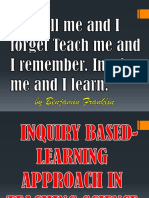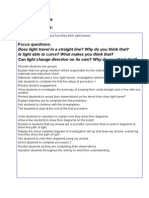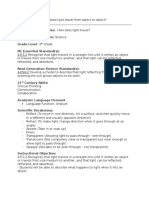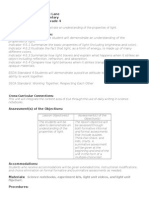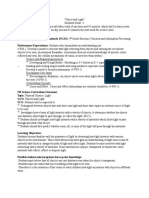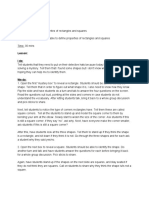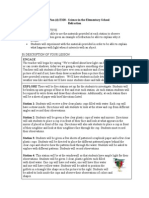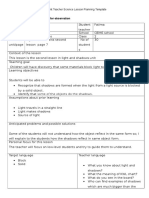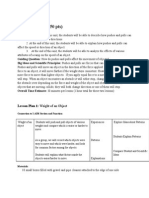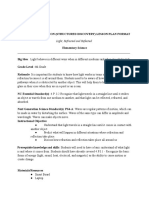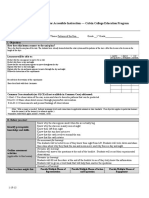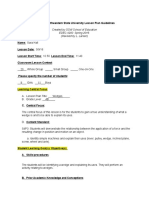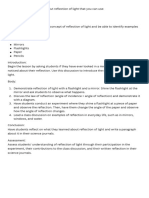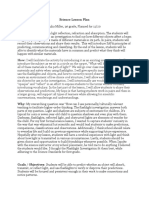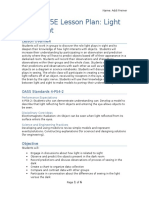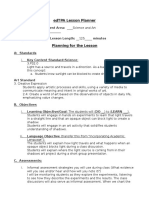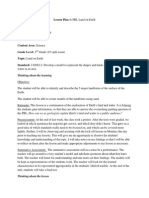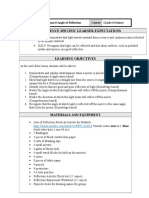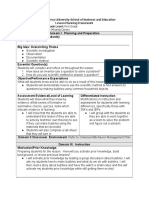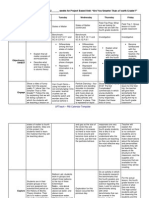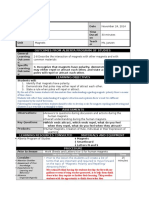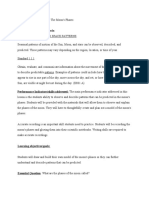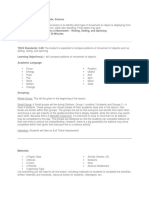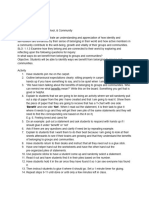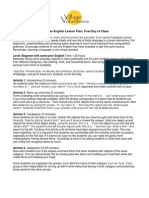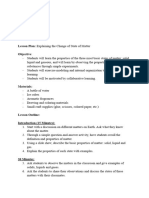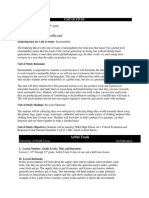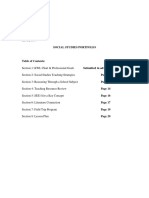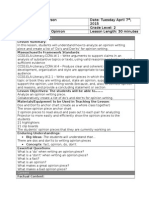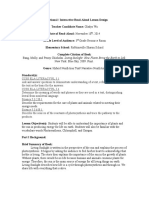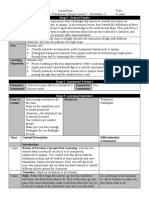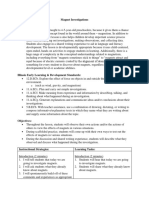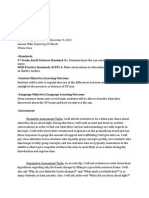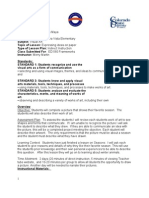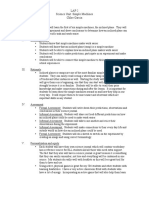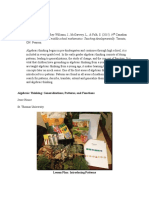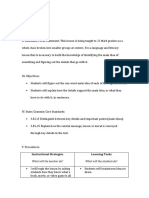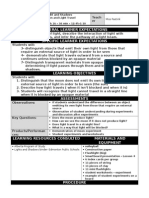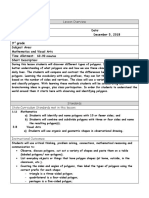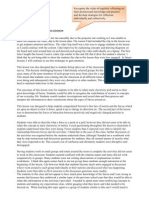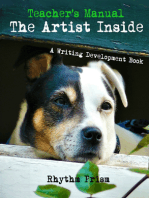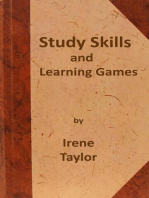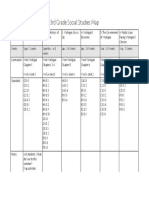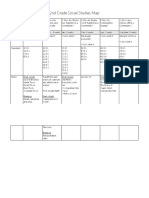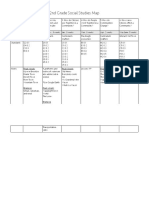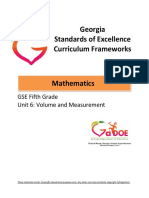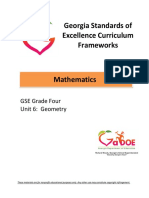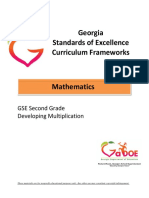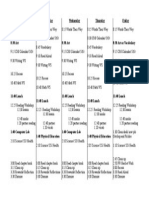Professional Documents
Culture Documents
Light Lesson
Light Lesson
Uploaded by
Cassandra MartinCopyright:
Available Formats
You might also like
- Inquiry Based Approach in ScienceDocument34 pagesInquiry Based Approach in ScienceDivine Grace Samortin86% (7)
- Light and Shadow UnitDocument33 pagesLight and Shadow Unitapi-240041355100% (1)
- Lesson Plan - Reversible and IrreversibleDocument6 pagesLesson Plan - Reversible and Irreversibleapi-341315630100% (2)
- Edfd Lesson PlanDocument11 pagesEdfd Lesson Planapi-357650573No ratings yet
- Lesson Summary LightDocument7 pagesLesson Summary LightCgzam ZamNo ratings yet
- Instruction TeacherDocument2 pagesInstruction Teacherapi-231581936No ratings yet
- Alston Lesson PlanDocument4 pagesAlston Lesson Planapi-336807116No ratings yet
- Teacher Candidate: Paige Lane School: Ninety-Six Elementary Subject/Grade: Science Grade 4 Learning Objective: Alignment With StandardsDocument9 pagesTeacher Candidate: Paige Lane School: Ninety-Six Elementary Subject/Grade: Science Grade 4 Learning Objective: Alignment With Standardsapi-200986451No ratings yet
- Object and LightDocument16 pagesObject and Lightapi-333161760No ratings yet
- Math LessonDocument2 pagesMath Lessonapi-439010488No ratings yet
- Refraction Science Lesson PlanDocument7 pagesRefraction Science Lesson Planapi-299488464No ratings yet
- Sample Science Lesson Plan - For ObservationDocument7 pagesSample Science Lesson Plan - For Observationapi-317701591No ratings yet
- Transparent Translucent Opaque Lesson Plan - Grade 4 ScienceDocument3 pagesTransparent Translucent Opaque Lesson Plan - Grade 4 Scienceapi-513798747No ratings yet
- Lesson Plan 6 With ReflectionDocument15 pagesLesson Plan 6 With Reflectionapi-317701591No ratings yet
- Oxford Science Fact File 3 Teaching GuideDocument96 pagesOxford Science Fact File 3 Teaching GuideAdnan Roonjha50% (10)
- Unit Plan Part 3: Lesson Plans (15/50 PTS)Document10 pagesUnit Plan Part 3: Lesson Plans (15/50 PTS)api-278225936No ratings yet
- IMb Science LessonDocument6 pagesIMb Science LessonAnonymous UG4paqNo ratings yet
- Lesson Planning Form For Accessible Instruction - Calvin College Education ProgramDocument5 pagesLesson Planning Form For Accessible Instruction - Calvin College Education Programapi-337267647No ratings yet
- Sara HallDocument6 pagesSara Hallapi-318116860No ratings yet
- Ngss Performance Expectation Assignment Table - Spring 2020Document5 pagesNgss Performance Expectation Assignment Table - Spring 2020api-514710806No ratings yet
- Sure! Here's A Lesson Plan About Reflection of Light That You Can UseDocument1 pageSure! Here's A Lesson Plan About Reflection of Light That You Can UseJohn Jomil RagasaNo ratings yet
- How: I Will Facilitate The Activity by Introducing It As An Exciting Investigation. I WillDocument5 pagesHow: I Will Facilitate The Activity by Introducing It As An Exciting Investigation. I Willapi-384662979No ratings yet
- Etl224 - L Menadue - Ass 1 2Document9 pagesEtl224 - L Menadue - Ass 1 2api-265137735No ratings yet
- Science 5e Lesson Plan AkfDocument6 pagesScience 5e Lesson Plan Akfapi-300376300No ratings yet
- Gabriela Gomez Edtpa Lesson Planner: A. Students Know Sunlight Can Be Blocked To Create ShadowsDocument8 pagesGabriela Gomez Edtpa Lesson Planner: A. Students Know Sunlight Can Be Blocked To Create Shadowsapi-323461891No ratings yet
- Ed 310 - Lesson 1Document3 pagesEd 310 - Lesson 1api-267592679No ratings yet
- Grade 4 Science Lesson 8Document12 pagesGrade 4 Science Lesson 8api-300873678No ratings yet
- SocraticseminarDocument4 pagesSocraticseminarapi-271086058No ratings yet
- Edu 223 - Lesson Plan 1Document3 pagesEdu 223 - Lesson Plan 1api-438638989No ratings yet
- SommerroesercalendarDocument9 pagesSommerroesercalendarapi-252829041No ratings yet
- Udl Lesson PlanDocument4 pagesUdl Lesson Planapi-269298910No ratings yet
- Lower Grade - Science Lesson Plan 1Document7 pagesLower Grade - Science Lesson Plan 1api-432453037No ratings yet
- Lessonplan 3Document3 pagesLessonplan 3api-485134991No ratings yet
- Nov28 GRDocument4 pagesNov28 GRapi-697899968No ratings yet
- Light Transparency Lesson 4Document7 pagesLight Transparency Lesson 4api-698236772No ratings yet
- Science LessonDocument5 pagesScience Lessonapi-666623410No ratings yet
- ESL Lesson Plan First ClassDocument2 pagesESL Lesson Plan First ClassWilson Barbosa GreenleaphNo ratings yet
- Lesson Plan Sample-KindergartenDocument10 pagesLesson Plan Sample-Kindergartenジェフリー リベラ100% (1)
- DesignhhhDocument13 pagesDesignhhhmerveozmen05No ratings yet
- Unit of Study: Artful TrashDocument10 pagesUnit of Study: Artful Trashapi-340992395No ratings yet
- Sims PortfolioDocument24 pagesSims Portfolioapi-240050520No ratings yet
- Julia Giordano 10 21 Lesson PlanDocument2 pagesJulia Giordano 10 21 Lesson Planapi-253760877No ratings yet
- Science 2016Document3 pagesScience 2016api-337438999No ratings yet
- Fact vs. Opinion WritingDocument4 pagesFact vs. Opinion WritingBrittanyNo ratings yet
- Transformers - 2Document2 pagesTransformers - 2api-253884078No ratings yet
- Living Sunlight Lesson PlanDocument6 pagesLiving Sunlight Lesson Planapi-306579573No ratings yet
- Transparent Translucent Opaque Lesson Plan Grade 4 ScienceDocument3 pagesTransparent Translucent Opaque Lesson Plan Grade 4 ScienceSyeda Raffat Hassan100% (2)
- Lesson 8 HardingDocument4 pagesLesson 8 Hardingapi-446884620No ratings yet
- Science Lesson Plan Uv BeadsDocument4 pagesScience Lesson Plan Uv Beadsapi-259165264No ratings yet
- Lesson Plan Indirect InstructionDocument4 pagesLesson Plan Indirect InstructionsunshinegrlNo ratings yet
- Takaki Lesson - Day 1 1Document4 pagesTakaki Lesson - Day 1 1api-282773559No ratings yet
- Lap 2 Science Unit: Simple Machines Chloe GarciaDocument5 pagesLap 2 Science Unit: Simple Machines Chloe GarciaMuhammad Asyraf ShaariNo ratings yet
- Peer Teaching ModuleDocument8 pagesPeer Teaching Moduleapi-350020856No ratings yet
- Task 1 LearningsegmentDocument11 pagesTask 1 Learningsegmentapi-353818531No ratings yet
- Lesson Plan 4 ScienceDocument4 pagesLesson Plan 4 Scienceapi-265908930No ratings yet
- Tgreenstem433 FinallessonexamDocument12 pagesTgreenstem433 Finallessonexamapi-384053421No ratings yet
- Nonfiction Reading and WritingDocument7 pagesNonfiction Reading and Writingaudreyslone05No ratings yet
- Forces Lesson 2 KatherineDocument4 pagesForces Lesson 2 Katherineapi-107166048No ratings yet
- 3rd Grade SS MapDocument1 page3rd Grade SS MapCassandra MartinNo ratings yet
- 3rd Grade SS MapDocument1 page3rd Grade SS MapCassandra MartinNo ratings yet
- 4th Grade Social Studies MapDocument1 page4th Grade Social Studies MapCassandra MartinNo ratings yet
- 2nd Grade SS MapDocument2 pages2nd Grade SS MapCassandra MartinNo ratings yet
- 2nd Grade SS MapDocument2 pages2nd Grade SS MapCassandra MartinNo ratings yet
- 4th - Math Unit 7 Angle MeasurementsDocument45 pages4th - Math Unit 7 Angle MeasurementsCassandra Martin0% (1)
- 2nd Grade SS MapDocument1 page2nd Grade SS MapCassandra MartinNo ratings yet
- 5 Math Unit 6Document110 pages5 Math Unit 6Cassandra MartinNo ratings yet
- 4th Math Unit 6Document96 pages4th Math Unit 6Cassandra MartinNo ratings yet
- Second Grade Unit 6Document89 pagesSecond Grade Unit 6Cassandra MartinNo ratings yet
- Weekly ScheduleDocument1 pageWeekly ScheduleCassandra MartinNo ratings yet
Light Lesson
Light Lesson
Uploaded by
Cassandra MartinOriginal Description:
Copyright
Available Formats
Share this document
Did you find this document useful?
Is this content inappropriate?
Report this DocumentCopyright:
Available Formats
Light Lesson
Light Lesson
Uploaded by
Cassandra MartinCopyright:
Available Formats
Light Unit Lesson 4
Overview: In this lesson the student investigate what happens when light bounces or reflects off things. They learn that when light hits an objects, it can bounce directly back, creating a mirror-like reflection, or bounce in many directions and scatter. They also use a model to describe what happens when light bounces.
Sources:
Science Companion- Light Lesson 4
Attending to the Learners Students will have learned about the path that light can take and will now start to move on to observing how light can bounce off of certain item. The students have learned a lot about the moon and how it reflects the suns light which is why it looks like it projects light. I anticipate that they will use this information to describe the reflection of light off of the tin foil. This is a very hands on activity so students of all concentration level will have an easier time staying focused. Students who also do not grasp the idea of light bouncing will also be able to look at the ping pong ball example. This is a more visual representation of the idea that light can bounce back in the same direction or scatter. Having the students engaged during the discussion after will also help them to stay focused. This visual will also help the student in my classroom that are English Language Learners. Learning Goals Students will: 1. Observe that light bounces or reflects off objects 2. Recognize that light can bounce directly back in the direction it came from, creating a mirror-like reflection, or bounce in many directions and scatter. S.IP.03.11 Make purposeful observation of the natural world using the appropriate senses S.IP.03.14 Manipulate simple tools that aid observation and data collection Instructional Sequence
Anticipating student ideas:
Making the content accessible to all students:
Learning Goals
Connection to Standards
Materials:
Aluminum foil (27 sheets) Flashlights-check that they are all working Ping pong balls Rocks World book *The flashlights and tin foil should be in different locations of the room but have one of each material ready to model for the class
What the teacher will do What students will do Students should come to the carpet quickly and quietly. One or a few students will talk about what we did as a class yesterday. The other students in the class should be attentive and looking at the students talking.
Time 5 min
Main components Set-up:
Call students to the carpet. Ask a student to explain what happened in science yesterday. Remind them that they saw how light can reflect off of surfaces such as mirrors or the white board and they began to draw some models of how light traveled when reflecting off an object. Explain that today we are going to look at how light bounces off some different surfaces. They will compare bumpy tin foil to flat tin foil.
Students should show active listening by looking at the teacher. 22 min Independent work on problem: Model the two experiments to the students. Model the first experiment where the flashlight should be held directly above the flat tin foil at a perpendicular angle. Tell them to record their observations on page 8 in their science journals. Students should continue active listening and start to ask question when necessary. They should be observing the modeling in front of the class.
Time
Main components
What the teacher will do Next model the second experiment where students should crumple the foil lightly and then conduct the same steps as in experiment 1. Before dismissing the students, ask some them to repeat the directions back to you to ensure understanding of the experiment. Have each partner get one of the materials needed before starting the experiment. Have students return the items and come to the carpet as a class to form a circle around the edge. Ask: What did you notice? What did you experience? Did you experience the same thing? Did anyone experience something different? After students have shared their experiences, try to find a connection that will transition into the model. Show the students the model of the ping pongs bouncing off of the flat book compared to bouncing off of the rocks. Explain that the ping pong balls are the light beams, the book is the flat tin foil, and the rocks are the bumpy tin foil. Ask: What did you notice? Do you see any similarities between this model and what we did with our experiments today? What do you think the light did when it hit the bumpy tin foil? Be sure to ask students to add onto others and ask for thumbs and then ask students why they agree or disagree. Review that light scatters when it is shined on a shiny bumpy surface and that light reflects at an angle when shined on a flat surface. Relate these concepts to the models. Give each student an exit slip to complete before the end of the lesson.
What students will do
Students will be working with their light science partner on this experiment. Students should be talking to their partner about their observations before they write anything down. Students should record all observations that are made.
5min
Launching of Discussion:
20 min
Orchestration of the Discussion:
Students should be watching the experiment. If some students seem a little antsy they can be chosen to help with the experiment.
Students should be raising their hands to comment on the model. They should be showing their thumbs in the up or down position to show their thoughts on their classmates thoughts.
1 min
Conclusion:
Student can ask any lingering question about the concept or model here. Student should draw these diagrams individually.
5 min
End-ofdiscussion check
Name:_________________________________ Date:___________________ Draw a diagram of what happens when light bounces off of a flat shiny surface (like foil). Include: The light source The surface The path of the light Draw a diagram of what happens when light bounces off of a bumpy shiny surface (like the crumpled foil). Include: The light source The surface The path of the light
You might also like
- Inquiry Based Approach in ScienceDocument34 pagesInquiry Based Approach in ScienceDivine Grace Samortin86% (7)
- Light and Shadow UnitDocument33 pagesLight and Shadow Unitapi-240041355100% (1)
- Lesson Plan - Reversible and IrreversibleDocument6 pagesLesson Plan - Reversible and Irreversibleapi-341315630100% (2)
- Edfd Lesson PlanDocument11 pagesEdfd Lesson Planapi-357650573No ratings yet
- Lesson Summary LightDocument7 pagesLesson Summary LightCgzam ZamNo ratings yet
- Instruction TeacherDocument2 pagesInstruction Teacherapi-231581936No ratings yet
- Alston Lesson PlanDocument4 pagesAlston Lesson Planapi-336807116No ratings yet
- Teacher Candidate: Paige Lane School: Ninety-Six Elementary Subject/Grade: Science Grade 4 Learning Objective: Alignment With StandardsDocument9 pagesTeacher Candidate: Paige Lane School: Ninety-Six Elementary Subject/Grade: Science Grade 4 Learning Objective: Alignment With Standardsapi-200986451No ratings yet
- Object and LightDocument16 pagesObject and Lightapi-333161760No ratings yet
- Math LessonDocument2 pagesMath Lessonapi-439010488No ratings yet
- Refraction Science Lesson PlanDocument7 pagesRefraction Science Lesson Planapi-299488464No ratings yet
- Sample Science Lesson Plan - For ObservationDocument7 pagesSample Science Lesson Plan - For Observationapi-317701591No ratings yet
- Transparent Translucent Opaque Lesson Plan - Grade 4 ScienceDocument3 pagesTransparent Translucent Opaque Lesson Plan - Grade 4 Scienceapi-513798747No ratings yet
- Lesson Plan 6 With ReflectionDocument15 pagesLesson Plan 6 With Reflectionapi-317701591No ratings yet
- Oxford Science Fact File 3 Teaching GuideDocument96 pagesOxford Science Fact File 3 Teaching GuideAdnan Roonjha50% (10)
- Unit Plan Part 3: Lesson Plans (15/50 PTS)Document10 pagesUnit Plan Part 3: Lesson Plans (15/50 PTS)api-278225936No ratings yet
- IMb Science LessonDocument6 pagesIMb Science LessonAnonymous UG4paqNo ratings yet
- Lesson Planning Form For Accessible Instruction - Calvin College Education ProgramDocument5 pagesLesson Planning Form For Accessible Instruction - Calvin College Education Programapi-337267647No ratings yet
- Sara HallDocument6 pagesSara Hallapi-318116860No ratings yet
- Ngss Performance Expectation Assignment Table - Spring 2020Document5 pagesNgss Performance Expectation Assignment Table - Spring 2020api-514710806No ratings yet
- Sure! Here's A Lesson Plan About Reflection of Light That You Can UseDocument1 pageSure! Here's A Lesson Plan About Reflection of Light That You Can UseJohn Jomil RagasaNo ratings yet
- How: I Will Facilitate The Activity by Introducing It As An Exciting Investigation. I WillDocument5 pagesHow: I Will Facilitate The Activity by Introducing It As An Exciting Investigation. I Willapi-384662979No ratings yet
- Etl224 - L Menadue - Ass 1 2Document9 pagesEtl224 - L Menadue - Ass 1 2api-265137735No ratings yet
- Science 5e Lesson Plan AkfDocument6 pagesScience 5e Lesson Plan Akfapi-300376300No ratings yet
- Gabriela Gomez Edtpa Lesson Planner: A. Students Know Sunlight Can Be Blocked To Create ShadowsDocument8 pagesGabriela Gomez Edtpa Lesson Planner: A. Students Know Sunlight Can Be Blocked To Create Shadowsapi-323461891No ratings yet
- Ed 310 - Lesson 1Document3 pagesEd 310 - Lesson 1api-267592679No ratings yet
- Grade 4 Science Lesson 8Document12 pagesGrade 4 Science Lesson 8api-300873678No ratings yet
- SocraticseminarDocument4 pagesSocraticseminarapi-271086058No ratings yet
- Edu 223 - Lesson Plan 1Document3 pagesEdu 223 - Lesson Plan 1api-438638989No ratings yet
- SommerroesercalendarDocument9 pagesSommerroesercalendarapi-252829041No ratings yet
- Udl Lesson PlanDocument4 pagesUdl Lesson Planapi-269298910No ratings yet
- Lower Grade - Science Lesson Plan 1Document7 pagesLower Grade - Science Lesson Plan 1api-432453037No ratings yet
- Lessonplan 3Document3 pagesLessonplan 3api-485134991No ratings yet
- Nov28 GRDocument4 pagesNov28 GRapi-697899968No ratings yet
- Light Transparency Lesson 4Document7 pagesLight Transparency Lesson 4api-698236772No ratings yet
- Science LessonDocument5 pagesScience Lessonapi-666623410No ratings yet
- ESL Lesson Plan First ClassDocument2 pagesESL Lesson Plan First ClassWilson Barbosa GreenleaphNo ratings yet
- Lesson Plan Sample-KindergartenDocument10 pagesLesson Plan Sample-Kindergartenジェフリー リベラ100% (1)
- DesignhhhDocument13 pagesDesignhhhmerveozmen05No ratings yet
- Unit of Study: Artful TrashDocument10 pagesUnit of Study: Artful Trashapi-340992395No ratings yet
- Sims PortfolioDocument24 pagesSims Portfolioapi-240050520No ratings yet
- Julia Giordano 10 21 Lesson PlanDocument2 pagesJulia Giordano 10 21 Lesson Planapi-253760877No ratings yet
- Science 2016Document3 pagesScience 2016api-337438999No ratings yet
- Fact vs. Opinion WritingDocument4 pagesFact vs. Opinion WritingBrittanyNo ratings yet
- Transformers - 2Document2 pagesTransformers - 2api-253884078No ratings yet
- Living Sunlight Lesson PlanDocument6 pagesLiving Sunlight Lesson Planapi-306579573No ratings yet
- Transparent Translucent Opaque Lesson Plan Grade 4 ScienceDocument3 pagesTransparent Translucent Opaque Lesson Plan Grade 4 ScienceSyeda Raffat Hassan100% (2)
- Lesson 8 HardingDocument4 pagesLesson 8 Hardingapi-446884620No ratings yet
- Science Lesson Plan Uv BeadsDocument4 pagesScience Lesson Plan Uv Beadsapi-259165264No ratings yet
- Lesson Plan Indirect InstructionDocument4 pagesLesson Plan Indirect InstructionsunshinegrlNo ratings yet
- Takaki Lesson - Day 1 1Document4 pagesTakaki Lesson - Day 1 1api-282773559No ratings yet
- Lap 2 Science Unit: Simple Machines Chloe GarciaDocument5 pagesLap 2 Science Unit: Simple Machines Chloe GarciaMuhammad Asyraf ShaariNo ratings yet
- Peer Teaching ModuleDocument8 pagesPeer Teaching Moduleapi-350020856No ratings yet
- Task 1 LearningsegmentDocument11 pagesTask 1 Learningsegmentapi-353818531No ratings yet
- Lesson Plan 4 ScienceDocument4 pagesLesson Plan 4 Scienceapi-265908930No ratings yet
- Tgreenstem433 FinallessonexamDocument12 pagesTgreenstem433 Finallessonexamapi-384053421No ratings yet
- Nonfiction Reading and WritingDocument7 pagesNonfiction Reading and Writingaudreyslone05No ratings yet
- Forces Lesson 2 KatherineDocument4 pagesForces Lesson 2 Katherineapi-107166048No ratings yet
- 3rd Grade SS MapDocument1 page3rd Grade SS MapCassandra MartinNo ratings yet
- 3rd Grade SS MapDocument1 page3rd Grade SS MapCassandra MartinNo ratings yet
- 4th Grade Social Studies MapDocument1 page4th Grade Social Studies MapCassandra MartinNo ratings yet
- 2nd Grade SS MapDocument2 pages2nd Grade SS MapCassandra MartinNo ratings yet
- 2nd Grade SS MapDocument2 pages2nd Grade SS MapCassandra MartinNo ratings yet
- 4th - Math Unit 7 Angle MeasurementsDocument45 pages4th - Math Unit 7 Angle MeasurementsCassandra Martin0% (1)
- 2nd Grade SS MapDocument1 page2nd Grade SS MapCassandra MartinNo ratings yet
- 5 Math Unit 6Document110 pages5 Math Unit 6Cassandra MartinNo ratings yet
- 4th Math Unit 6Document96 pages4th Math Unit 6Cassandra MartinNo ratings yet
- Second Grade Unit 6Document89 pagesSecond Grade Unit 6Cassandra MartinNo ratings yet
- Weekly ScheduleDocument1 pageWeekly ScheduleCassandra MartinNo ratings yet
